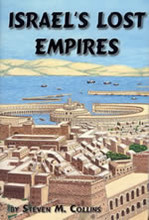 Loading... Please wait...
Loading... Please wait...Categories
New Products
-
$240.00

-
$75.00

-
$150.00

-
$240.00

-
$120.00

Our Newsletter
- Home
- Hebrew Heritage Books
- Israels Lost Empires
Israels Lost Empires
Product Description
Israel's Lost Empires
by Steven M. Collins
This book of 280 pages softcover takes the reader on a historical tour of Israel’s colonization of western lands in early times. This is a subject almost totally unknown to modern readers, despite the fact that it is documented in the Bible. We read, “And King Solomon made a navy of ships in Eziongeber, which is beside Eloth, on the shore of the Red sea, in the land of Edom. And Hiram sent in the navy his servants, shipmen that had knowledge of the sea, with the servants of Solomon.” (1 Ki. 9:26-27) Scripture further tells us, “For the king had at sea a navy of Tharshish with the navy of Hiram: once in three years came the navy of Tharshish, bringing gold, and silver, ivory, and apes, and peacocks.” Historians debate the true location of Tharshish, (modern spelling, Tarshish), but evidence suggests that it was located somewhere in the west.
In his opening chapter, author Steven Collins discusses the golden age of the Israel-Phoenician Empire, and shows that Solomon and David were the real power brokers of that era. Phoenicia was a small strip of territory about ten miles wide along a small section of the Mediterranean coast, and a look at the map shows that the nation of Israel far exceeded it in size. Yet the Phoenicians today receive all of the credit for the scientific and navigational skills of the era, as if the Israelites had no participation at all. The Bible disagrees with that assessment. King Solomon is revealed to have “exceeded all the kings of the earth for riches and for wisdom.” (1 Ki. 10:23) How did he accomplish such riches without foreign trade and colonization?
If this is indeed true, why does such confusion prevail concerning ancient Israel and Phoenicia? The Israelites spoke the same Semitic language dialect as the Phoenicians, and much of the “Phoenician” trade was in fact Israelite. Author Steven Collins discusses the “Phoenician colony” of Carthage on the North African coast and shows that it was actually founded by the grandniece of the king and queen of Israel, and that important Carthaginians had Biblical names! The author takes us back to the events of that era and shows that the reason for the founding of the colony was due to a famine in the land of Israel. In a fascinating and well-researched chapter entitled, “Carthage—Israel’s Colony Became An Empire,” the author gives a seemingly endless stream of startling information that shows the many connections between Israel and Carthage that have never before been gathered together in one book.
Carthage itself grew in numbers of people that, according to scholars, at one point reached nearly a million citizens. This colony then sent out its own colonizing expeditions, both northward to Europe and westward to Britain and even North America. The fascinating evidence of possible Carthaginian visits to the Americas makes for fascinating reading, with photographs of locations of feasible early visits by Carthaginian vessels seeking trade and settlement.
The final portion of the book takes us on land migrations by the Israelites, and gives convincing evidence that the Scythian tribes known as “Sacae” were in fact the sons of Isaac. The ancient first-century, A.D., Hebrew writer, Flavius Josephus, himself expressed that the “ten tribes” of the House of Israel were no longer in Palestine or the Mideast, and no longer in lands controlled by the Romans, but “beyond the Euphrates…an immense multitude, and not to be estimated by numbers.” (See Collins page 191) This would place them to the north of Palestine and east of Roman controlled territory; in other words, at the eastern doorway of Europe. The book gives much other evidence, including reference to Assyrian documents of the pre-Christian centuries to support this conclusion.
Author Collins quotes many scholarly sources to show the striking resemblances between the Scythians and the Israelites. Of particular interest is the quotation from ancient Greek historian, Herodotus, telling that the Sacae customs included a prohibition of pigs, “nor will they keep them at all in their country.” (p. 211) One of the Scythian-Sacae kings was named Saulius, which may indeed be a Hebrew name, and perhaps even a designation of a royal descendant of the Biblical king Saul. Other cultural connections include clothing, and the striking resemblance of the Scythian-Sacae pointed hat to that of the Hebrew priesthood.
In addition, the author points out the Biblical evidence that the Abrahamic Covenant in Genesis 21:12 “promised that Abraham’s future descendants would be known by the name of Isaac.” (Collins page 197) This Biblical passage reads, “And God said unto Abraham, Let it not be grievous in thy sight because of the lad, and because of thy bondwoman; in all that Sarah hath said unto thee, hearken unto her voice; for in Isaac shall thy seed be called.”
So much more about the unknown history of ancient Israel is covered, or perhaps we should say “uncovered,” in this well-written book. It is without doubt a veritable treasure of important and little-known historical information that will keep the reader engrossed to the last page. Very well documented, the book includes over 100 maps, charts, and illustrations, and 27 pages of extensive indices. Published by Bible Blessings, soft cover, second edition. We highly recommend this book!
Table of Contents:
Chapter 1: Golden Age of the Israelite-Phoenician Empire
Scope of the Israelite-Phoenician Empire
Phoenician Scientific and Navigational Skills
Israel’s role in the Phoenician Empire
Phoenician “Mound Builders” of Ancient America
Israel’s Role in the Phoenician Empire
The Phoenicians in Ancient South America
The “Covenant” Empire
Chapter 2: Israel’s Decline and Migration From Palestine
Israel and Judah Become Rival Kingdoms
The Great Civil War Between the Israelites and the Jews
Evil King Ahab and the Devastating Drought of Prophet Elijah
Jonah, the Misunderstood Prophet
The Fall of the Kingdom of Israel
Israel’s Maritime Migrations to Phoenician Colonies
Overland Migrations of Israelites to the Black Sea Region
The Fall of the Kingdom of Judah
Chapter 3: Carthage—Israel’s Colony Became An Empire
The Israelite Origins of Carthage
Carthage Rallies Israel’s Colonies to Counter Greece
Carthaginian Colonies in Europe and the Ancient Americas
Carthaginian Society and Customs
Hannibal and the Punic Wars with Rome
The Carthaginian Presence in Ancient America
Carthage, the Mayans and Ancient American Mines
Carthaginian Elephants in the Americas?
Chapter 4: The Scythian Sacae, the Asian “Sons of Isaac”
The Ten Tribes of Israel Become “the Scythians”
Scythian Culture and Society
Scythia Conquers the Assyrian Empire
King Josiah of Judah and the Scythians of Palestine
The Persian-Scythian Wars
The Apostle Paul and the Scythians
Epilogue
Bibliography
Index: Scripture References
Index: Persons, Places, Subjects
Photo-book Tour
Recommended Reading
Read an excerpt from this important book at http://israelite.info/bookexcerpts/israelslostempires.html













